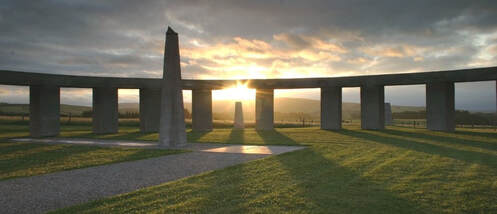History of the Phoenix Astronomical Society
The Phoenix, a beautiful bird in mythology, is a symbol of resurrection and re-birth. The Phoenix Astronomical Society arose from the ashes of the Black Birch Observatory in the stunning South Island. Black Birch Mountain is in the South Island of Aotearoa/New Zealand, near Blenheim, and used to be the site of the Carter Observatory’s outstation and also the United States’ Naval Observatory, the latter suspected by many New Zealand peace campaigners of being engaged in weapons guidance systems. When the U.S. pulled out of Black Birch, the automated dome of one of their observatories was offered to founder members of TPAS.
The Phoenix, a beautiful bird in mythology, is a symbol of resurrection and re-birth. The Phoenix Astronomical Society arose from the ashes of the Black Birch Observatory in the stunning South Island. Black Birch Mountain is in the South Island of Aotearoa/New Zealand, near Blenheim, and used to be the site of the Carter Observatory’s outstation and also the United States’ Naval Observatory, the latter suspected by many New Zealand peace campaigners of being engaged in weapons guidance systems. When the U.S. pulled out of Black Birch, the automated dome of one of their observatories was offered to founder members of TPAS.
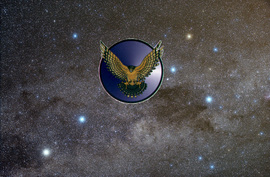
At our first meeting in December 1997 about 25 people interested in building a dark sky observatory attended and the purpose, organisation and activities of the proposed new society was the subject under discussion. Initially most of the membership was Wellington-based but we now have members from around New Zealand and overseas. Our membership includes absolute beginners, schoolchildren and students, educators, telescope-makers, experts in electronics, optical systems, and various areas of research astronomy. One of the features of the science of astronomy is that it attracts people from a wide variety of backgrounds. Some of our members are professional astronomers, some have PhD’s in astrophysics, others have a lifetime’s experience as an amateur astronomer, but many are relatively new to stargazing. The primary aim of the society is to cater for everyone, and to make astronomy accessible to all members, whatever their level of interest and
knowledge.
Like topsy TPAS grew rapidly and it became very clear that, as most members were new to astronomy, building a recreational observatory was more urgent than he originally planned research observatory. However, as a new society we didn’t have lots of funds, nor did we have a financial track record, so we have had to be creative in finding ways to raise money. Our members, our greatest asset, have been very supportive and cash donations, some of them very substantial, have been absolutely essential in enabling us to provide one of the best amateur observatories in the country. Other members have offered support in kind by participating in working bees, and helping to make our fund-raising activities so successful. This is what makes TPAS special: we have a friendly and enthusiastic membership that generally gets in behind and supports our many projects. We couldn’t do it without them!
knowledge.
Like topsy TPAS grew rapidly and it became very clear that, as most members were new to astronomy, building a recreational observatory was more urgent than he originally planned research observatory. However, as a new society we didn’t have lots of funds, nor did we have a financial track record, so we have had to be creative in finding ways to raise money. Our members, our greatest asset, have been very supportive and cash donations, some of them very substantial, have been absolutely essential in enabling us to provide one of the best amateur observatories in the country. Other members have offered support in kind by participating in working bees, and helping to make our fund-raising activities so successful. This is what makes TPAS special: we have a friendly and enthusiastic membership that generally gets in behind and supports our many projects. We couldn’t do it without them!
Building the Observatory

Our first project was to build a recreational observatory in the Wairarapa on privately-owned land. Why the Wairarapa? Well we looked for somewhere close to Wellington, easily accessible but unpolluted by too much light. The convenience
of stargazing from your own backyard should not be underestimated, and it certainly is the place to learn initially to find your way around the sky – binoculars are ideal for beginners. However, anyone with a real interest in astronomy eventually finds that they want to see more, and see better, and for that you need a dark sky. If you haven’t been to the Wairarapa yet, please make the effort to do so – you’ll see the night sky as you may never have seen it before. On a clear, moonless night the Milky Way and the Magellanic Clouds are magnificent, and through the Phoenix telescopes the stars along the Milky Way are a mass of multi-coloured gems. You can view the spiral arms of galaxies (plural), and can see colour in many nebulae.
of stargazing from your own backyard should not be underestimated, and it certainly is the place to learn initially to find your way around the sky – binoculars are ideal for beginners. However, anyone with a real interest in astronomy eventually finds that they want to see more, and see better, and for that you need a dark sky. If you haven’t been to the Wairarapa yet, please make the effort to do so – you’ll see the night sky as you may never have seen it before. On a clear, moonless night the Milky Way and the Magellanic Clouds are magnificent, and through the Phoenix telescopes the stars along the Milky Way are a mass of multi-coloured gems. You can view the spiral arms of galaxies (plural), and can see colour in many nebulae.
The Grand Opening

The recreational observatory was opened in July 1999 by Georgina Beyer, then Mayor of Carterton, now Member of Parliament for the Wairarapa. The opening ceremony included the blessing of the observatory site by a local Maori tohunga
and Anglican minister, and was attended by over 150 people. The observatory contains four telescopes – the 6” F18 refractor that used to belong to Peter Read is on loan from the Carter Observatory; the 8” Meade Schmidt-Cassegrain telescope and the Phoenix 12” and 23” Dobsonian reflectors.
We also have an astrograph for astrophotography and a number of our members have become extremely talented as you can see on our webpage gallery . Many of their photographs have appeared in national and international publications and
websites.
and Anglican minister, and was attended by over 150 people. The observatory contains four telescopes – the 6” F18 refractor that used to belong to Peter Read is on loan from the Carter Observatory; the 8” Meade Schmidt-Cassegrain telescope and the Phoenix 12” and 23” Dobsonian reflectors.
We also have an astrograph for astrophotography and a number of our members have become extremely talented as you can see on our webpage gallery . Many of their photographs have appeared in national and international publications and
websites.
Telescopes for everyone
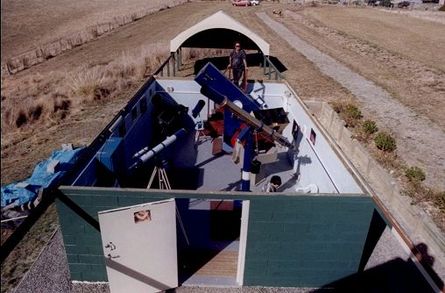
The range of telescopes gives members the opportunity to view through a variety
of instruments and assess the pluses and minuses of each. If they are looking
to buy their own telescope then this can help them decide on the best instrument for their needs, as no telescope is completely multipurpose; the type of telescope to buy depends on what one wants to observe with it. The 15cm (6") Peter Read refractor is an excellent instrument for planetary and double star observation; the automated 20cm (8") Schmidt-Cassegrain is a good general purpose wide-field instrument, also good for astrophotography; the 12” Dobsonian is a really good telescope for beginners to use; and the Phoenix 58 cm (23") reflector is best for deep space objects such as nebulae and galaxies.
Few individuals would be able to afford to purchase the range of telescopes
provided by TPAS, so the observatory gives anyone with the price of the
membership fee the opportunity to view and photograph the night sky in all its
splendour.
A second observatory, named the Nankivell Observatory after Garry Nankivell,
who made the optics for the 1 meter telescope at Mount John, has been rebuilt to house a Schmidt camera and telescope made and used by Garry; this will be used to produce wide field astronomical photographs. The Matariki Research Observatory, is progressing under the guidance of Roger Gibb, Bernard Watt and Alan Tarrant. The optical system has been designed by Norman Rumsey, a world-renowned optics expert; the glass is being figured by Graeme Jonas, previously of Taranaki, currently in Wellington. Research projects will be in the steady hands of Dr. Richard Dodd, ex Director of the Carter National Observatory of New Zealand. Once completed we will have a top class 24” research-grade telescope that will, with CCD camera and adaptive optics, have the ability to image objects that at one time needed something like the 200” Palomar telescope. The telescope and observatory will be completely automated with its own electronic guidance system and computers for data processing.
of instruments and assess the pluses and minuses of each. If they are looking
to buy their own telescope then this can help them decide on the best instrument for their needs, as no telescope is completely multipurpose; the type of telescope to buy depends on what one wants to observe with it. The 15cm (6") Peter Read refractor is an excellent instrument for planetary and double star observation; the automated 20cm (8") Schmidt-Cassegrain is a good general purpose wide-field instrument, also good for astrophotography; the 12” Dobsonian is a really good telescope for beginners to use; and the Phoenix 58 cm (23") reflector is best for deep space objects such as nebulae and galaxies.
Few individuals would be able to afford to purchase the range of telescopes
provided by TPAS, so the observatory gives anyone with the price of the
membership fee the opportunity to view and photograph the night sky in all its
splendour.
A second observatory, named the Nankivell Observatory after Garry Nankivell,
who made the optics for the 1 meter telescope at Mount John, has been rebuilt to house a Schmidt camera and telescope made and used by Garry; this will be used to produce wide field astronomical photographs. The Matariki Research Observatory, is progressing under the guidance of Roger Gibb, Bernard Watt and Alan Tarrant. The optical system has been designed by Norman Rumsey, a world-renowned optics expert; the glass is being figured by Graeme Jonas, previously of Taranaki, currently in Wellington. Research projects will be in the steady hands of Dr. Richard Dodd, ex Director of the Carter National Observatory of New Zealand. Once completed we will have a top class 24” research-grade telescope that will, with CCD camera and adaptive optics, have the ability to image objects that at one time needed something like the 200” Palomar telescope. The telescope and observatory will be completely automated with its own electronic guidance system and computers for data processing.
Clubrooms
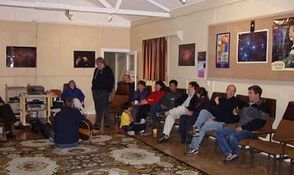
TPAS has its own on-site clubroom that was moved on 1st May 2001. The purpose of the clubrooms is to provide facilities for meetings, a place to relax and warm-up in between a cold night's astronomical activities, and a library. This too has been a wonderful example of our members’ generosity as people have donated not only time to paint, repair, and wire the building, but also items (and some cash) to furnish and generally make the building more comfortable. A grant from the Tararua Foundation assisted with the cost of a new floor, the Eastern and Central Community Trust and the Lotteries Gaming Commission provided the wherewithal to add plumbing and toilet facilities. Oticon provided the funding for a hearing loop.
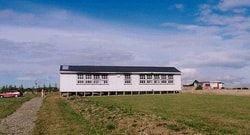
Stonehenge Aotearoa
After constructing the clubrooms, we went about the construction of Stonehenge Aotearoa, not a ruin like the original in England, but one specially designed for this location. This is an educational astronomical tool for young and old and enhances the magnificent rural Wairarapa landscape with the Tararua Ranges as a stunning backdrop.
After constructing the clubrooms, we went about the construction of Stonehenge Aotearoa, not a ruin like the original in England, but one specially designed for this location. This is an educational astronomical tool for young and old and enhances the magnificent rural Wairarapa landscape with the Tararua Ranges as a stunning backdrop.
The Adventure continues ...
As should now be clear, in the last several years TPAS has been a very active society with two observatorys built and a reseach site in development; one clubrooms, several New Zealand Almanacs published and a small number of books.
We hold Stardate around February/March each year. Our monthly meetings are held at our clubrooms or other locations in the Wairarapa, with regular observations or starparties (weather permitting). Plus special meetings such as those for the Leonid Meteor Shower; an annual Solstice Dinner, musical evenings and barbecues. We also produce our monthly bulletin and our webpage.
The Phoenix Astronomical Society maintains links with most New Zealand astronomical societies and is affiliated to the Royal Society (Wellington Branch)
As should now be clear, in the last several years TPAS has been a very active society with two observatorys built and a reseach site in development; one clubrooms, several New Zealand Almanacs published and a small number of books.
We hold Stardate around February/March each year. Our monthly meetings are held at our clubrooms or other locations in the Wairarapa, with regular observations or starparties (weather permitting). Plus special meetings such as those for the Leonid Meteor Shower; an annual Solstice Dinner, musical evenings and barbecues. We also produce our monthly bulletin and our webpage.
The Phoenix Astronomical Society maintains links with most New Zealand astronomical societies and is affiliated to the Royal Society (Wellington Branch)
